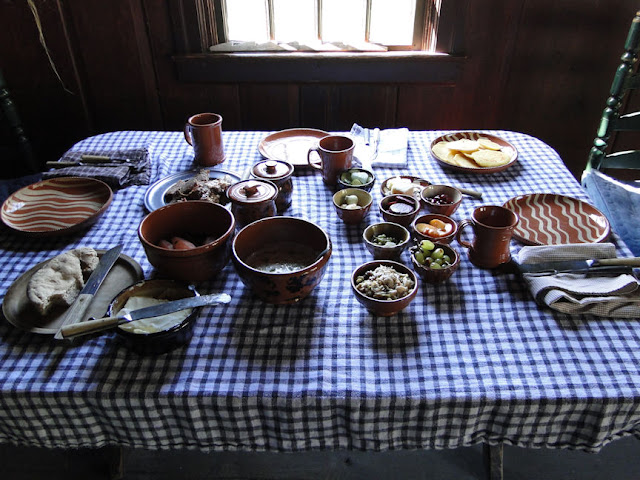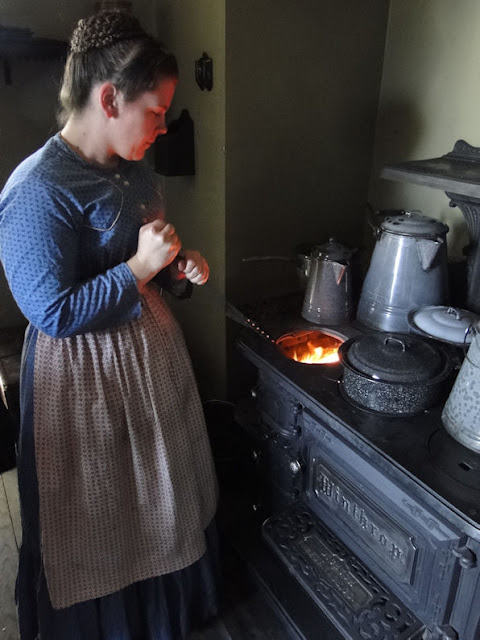 |
| An autumn scene right out of 1760. Yeah, I was there... |
Even though nostalgia is defined by Mr. Webster as "a wistful desire to return in thought or in fact to a former time in one's life," I once read that nostalgia is also portable, meaning that it is possible to feel a sentimental attachment to a time period one didn't personally live through.
It's pretty obvious that I was not around during the horse-and-carriage days in which I purport to live during reenactments, and yet I still have a sort of nostalgic feeling for those times.
Maybe it's because, besides actively participating for over a decade in the world of mid-19th century living history, I have also been around the historical open-air museum of Greenfield Village (and, to a lesser extent, Crossroads Village) so much for most of my life, witnessing daily life of the 18th and 19th centuries, that I can actually have a sort of Webster definition of nostalgia for times long past - even before my great grandparent's time.
 |
| I was also in 1882... |
But it can also be the traditions that so many in the modern world take part in that can give a nostalgic feeling for times before our own.
And that's where the season of autumn comes into play.
To me, fall just exudes history. From the city dwellers traveling down the country roads for cider, donuts, hay rides, and farmer's markets, to the hunters who go off to practice that most basic of human sport, to the sight and smell of autumn leaves - either on or falling off the trees or even burning in a yard. All of this tells me that late September, October, and November are probably the three most traditional/historical months of the calendar. Name me another time of year here in the 21st century that so many folks will visit a mill - that backbone of 19th century life - of any kind.
Which leads me to autumn and its association to historical Greenfield Village.
They seem to go hand in hand, don't you think?
Yep, my family and I spent a day enjoying most of the pleasures and traditions of the fall season while visiting our favorite historical place.
For two weekends in the early autumn the Village celebrates the harvest by holding a Fall Flavors Weekend where one can "experience cooking demonstrations, a farmers market, special themed dinners, local product samplings, tastings, and more" (from their brochure).
But it's more than just about food; it's a feeling one gets when surrounded by historic structures, period-dressed presenters, changing leaves, and a cool breeze.
And, yes, the food.
The kind of food found cooking in wood stoves or hearths in the autumns of long ago. At Greenfield Village, six houses were being used for cooking demonstrations, each one from a different era in our nation's history. Won't you join me as we travel into the past to visit each house by the year of its presentation, beginning way back in the colonial times:
 |
| Daggett House from 1760 |
 |
| Preparing roast beef, johnnycakes, rice custard, and potato pudding inside colonial Daggett House |
 |
| A colonial feast! |
Now onto the 1860 Susquehanna Plantation:
Oh! The smells that greet you as you walk inside these historic homes!
 |
| The poor Susquehanna ladies are plum tired, and the day is not over yet! |
Next we'll head to the Adams House from the 1870's:
The Adams home, built around 1840, is one that I have imagined that I would live in had I lived back then. I'm not sure why, but it just seems to say to me, "Come in. Welcome home!"
 |
| In this woodstove is baking a savory rabbit pie. |
 |
| A table decked out with autumn vegetables, including Heidelberg cabbage |
At the Ford Farm it's 1876...
 |
| ...and the ladies of the Ford home are quite busy this autumn day preparing beef hotch-potch, fried cabbage, apple brown betty, and pumpkin fritters |
 |
| Every ingredient was homegrown on their farm, though... |
 |
| ...they could have gone to their "local" general store (only a few miles walk from their home!) and purchased whatever they needed. It was cheaper to grow your own! |
And now we travel a few years into the future, to the farm owned by the Firestones in 1882.
 |
| A beautiful fall setting greets us as we make our way to Firestone Farm. Can you see the farm workers in the field? |
 |
| Besides the macaroni noodles, the ladies of the farm are making baked chicken pie, stuffed squash, and potato bread. |
 |
| Like the Ford Farm, all of their ingredients are homegrown and readily available just by stepping down into the cellar. |
 |
| It takes a while and quite a bit of stoking to get the stove at a good baking temperature. |
From 1882 we jump a few decades into the future to the homestead of Thomas Edison's grandparents, set for 1915.
 |
| Early signs of autumn are beginning to show. |
 |
| Yes, Hallowe'en was celebrated quite extravagantly in many houses in 1915. |
 |
| I see a roast chicken, pumpkin pie, and other delectable delights on the thoroughly modern (for 1915) stove |
 |
| A fine fall greeting at the kitchen doorway |
And finally we have the Mattox Home from the 1930's:
 |
| Such a tiny stove for a family, even during the Great Depression. |
 |
| Simmering pork chops, fried sweet potatoes, baked corn muffins, and spicy gingerbread is what the lady of the house has planned for her family. |
The Firestone Farm also had a threshing machine from 1904 that was in fine working order, showing the many visitors how it could separate the grain from the stalks. Something I did not know until the day we visited (September 29) was that it was rare for a farmer to own his own threshing machine, for it was much too expensive. However, many times local farmers who lived near each other would pool their money and "rent" the machine by having its owner take it from farm to farm to have their grain threshed.
 |
| The 1904 threshing machine in action. Can you imagine how thrilled farmers were to have such a machine do this back-breaking labor for them? . |
Throughout the farm acreage the visitors could watch and question the men of Firestone Farm, who were busy working in the fields, gathering stalks, harvesting vegetables, and "winterizing" the land.
Fascinating.

By the way, normally we are able to learn about and even taste the heirloom apples growing in the Firestone orchards, brands such as Rambo, Baldwin, Belmont, Roxbury Russet, and Hubbardston Nonesuch can normally be found there, all having different characteristics, flavors, and ultimately were used in different ways, either for sale, or for the family’s own use. Unfortunately, we here in Michigan had quite an unusual spring in 2012 with a week-long string of 70 and 80 degree temperatures in mid-March when it should have still been in the 30's and 40's, and then suddenly dropping down into the 20's and 30's. That sealed the fate of our fall apple season, including the heirloom apples at the Village.
Ah well, nature has its own ways, doesn't it?
 Another
neat thing that Greenfield Village had was a farmer's market, a place
where one could purchase nearly anything MADE or GROWN IN MICHIGAN from
vegetables to maple syrup to broomsticks to homemade soap to honey to
fruit not affected by the spring weather to ground flour to pumpkins,
gourds, & squash to, well, you name it.
Another
neat thing that Greenfield Village had was a farmer's market, a place
where one could purchase nearly anything MADE or GROWN IN MICHIGAN from
vegetables to maple syrup to broomsticks to homemade soap to honey to
fruit not affected by the spring weather to ground flour to pumpkins,
gourds, & squash to, well, you name it.  |
| This young lady makes and sells her own soap |
This year it seems that Greenfield Village is getting so much closer to its now long-defunct Fall Harvest Weekend from the 1990's where, besides what I mentioned above, they used to also show the process of winnowing, giving hay rides, live old-time music from a string band, cider & doughnuts, and the procedure of 19th century corn shucking. I certainly hope they do bring some of this back, for I would gladly forgo the overly expensive cider mill and its animated hillbilly bears and haunted houses to visit a real authentic harvest weekend.
 |
| A broom maker's wares at the farmer's market |
If you would like to read more about how harvest time was celebrated in the 18th and 19th centuries please click HERE.
.



4 comments:
Hope to get there this next weekend. Looks like alot of fun!
I LOVE the working kitchens! At the Whaley House museum we have a functional 1850's stove that we've used ONE time years ago. I wish we would have more cooking demonstrations. They bring the house to life. The aroma of food is such an organic, natural thing that makes a house a home.
Speaking of cider....not sure how you or your readers feel about 'ghosts' but as our museum has a national reputation for being haunted, I attended a special paranormal investigation this last weekend. They used a weird thing called an obelisk which has Webster's dictionary and phonetics programmed into it, that supposedly the spirits can form words and sentences out of. Sounds like a robot.
I'd recently found in one of the family journals a reference to a food called 'Roly Poly, which I'd never heard of, so I asked out loud what was used in Roly Poly. The obelisk said very clearly "CIDER". I had figured that Roly Poly was some sort of a dessert, so the cider response surprised me. I asked, "Is this a DESSERT?" The obelisk said "YES".
So I researched Roly Poly the next morning and lo and behold, it's a very old recipe, a pudding typically steamed in a bath of hot CIDER.
Don't know if this obelisk thing is on the level, or if there are really spirits or ghosts, but it sure was an interesting evening! And now I MUST attempt to make Roly Poly! I just wish I could make it in the Whaley House kitchen!
Rabbit pie? Oh my! I would not pick up that recipe card. That is neat that recipe cards were available at each place. Loved all of the photos, thanks for sharing. Gina
Ken,
Thanks for the tours. Wonderful pictures and vivid sentiments.
Wish we were there on every pose.
Post a Comment